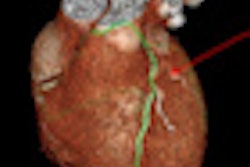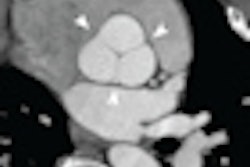CT can accurately predict clinical outcomes in myocardial infarction patients who undergo percutaneous coronary interventions (PCI), according to research in the February 21 edition of the Journal of the American College of Cardiology.
Specifically, the size of the delayed enhancement region at contrast-enhanced CT immediately after PCI was a significant independent predictor of cardiac events, offering "important prognostic value in predicting the success of the procedure," wrote Dr. Akira Sato and colleagues from the University of Tsukuba in Japan and two other centers (JACC, Vol. 59:8, pp. 730-738).
Some studies have suggested that delayed enhancement size is important after PCI, but only limited clinical experience is available, Sato and colleagues wrote. The group scanned 102 patients immediately after PCI without reinjecting contrast, measuring the size of myocardial contrast delayed enhancement at MDCT and comparing it with clinical outcomes over a mean 24 months (± 10 months). Cardiac death or hospitalization for worsening heart failure were considered primary cardiac events.
In all, 19 patients had such events -- seven with cardiac death and 12 with heart failure. Statistical analysis showed a higher risk of events for patients in the third tertile of myocardial contrast delayed enhancement (DE) size (> 36 g), compared with the other two size categories (p < 0.0001).
Additional analysis showed that myocardial contrast delayed enhancement size was a significant independent predictor for cardiac events after adjustment for Thrombolysis in Myocardial Infarction (TIMI) risk score, left-ventricular ejection fraction, total defect score on SPECT with technetium-99m tetrofosmin, and transmural extent of myocardial contrast DE on MDCT.
"Most importantly in the present study, the patients with larger myocardial contrast DE size had a greater incidence of cardiac events and worse long-term prognosis than those with smaller DE size," the authors wrote. While MRI is an established modality for assessing myocardial infarction, CT's shorter scan times and wide availability are important advantages, they added.
Myocardial contrast DE size is an important predictive marker for future clinical cardiac events and may add incremental prognostic value over that of typical measures such as left-ventricular ejection fraction and TIMI risk score, Sato and colleagues concluded.



















